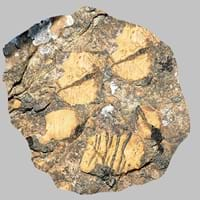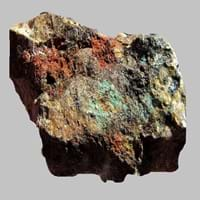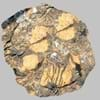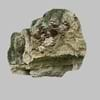Definition
Diamictite is a sedimentary rock that consists of non-sorted to poorly sorted terrigenous sediment containing particles that range in size from clay to boulders, suspended in a matrix of mudstone or sandstone
Jasperoid is a rare, peculiar type of metasomatic alteration of rocks
Origin
Southern Mongolia
USA
Discoverer
Unknown
Unknown
Etymology
From Greek dia through and meiktós or mixed
From silica, the main mineral content of Jasperoid
Class
Sedimentary Rocks
Sedimentary Rocks
Sub-Class
Durable Rock, Soft Rock
Durable Rock, Medium Hardness Rock
Group
Not Applicable
Not Applicable
Other Categories
Coarse Grained Rock, Opaque Rock
Coarse Grained Rock, Fine Grained Rock, Medium Grained Rock, Opaque Rock
Color
Brown, Buff
Black, Brown, Colourless, Green, Grey, Pink, White
Durability
Durable
Durable
Appearance
Banded
Glassy or Pearly
Interior Uses
Decorative Aggregates, Interior Decoration
Decorative Aggregates, Floor Tiles, Homes, Interior Decoration
Exterior Uses
As Building Stone, Paving Stone
As Building Stone, Garden Decoration, Office Buildings, Paving Stone
Other Architectural Uses
Curbing
Curbing
Construction Industry
As Dimension Stone, Construction Aggregate, for Road Aggregate, Landscaping, Roadstone
As a Flux in the Production of Steel and Pig Iron, As a Sintering Agent in Steel Industry to process Iron Ore, As Dimension Stone, Cement Manufacture, for Road Aggregate, Making natural cement, Manufacture of Magnesium and Dolomite Refractories, Production of Glass and Ceramics, Serves as an Oil and Gas Reservoir rock
Medical Industry
Not Yet Used
Taken as a Supplement for Calcium or Magnesium
Antiquity Uses
Artifacts
Artifacts, Jewellery, Monuments, Sculpture
Commercial Uses
Commemorative Tablets, Creating Artwork, Production of Lime
An Oil and Gas Reservoir, As a Feed Additive for Livestock, Gemstone, Metallurgical Flux, Production of Lime, Soil Conditioner, Source of Magnesia (MgO)
Types
Bedded Diamictite and Laminated Diamictite
Not Available
Features
Host Rock for Lead, Is one of the oldest rock
Host Rock for Lead, Traps for subsurface fluids like Oil and Natural Gas., Zinc and Copper Deposits
Archaeological Significance
Monuments
Not Yet Used
Used
Famous Monuments
Not Applicable
Data Not Available
Sculpture
Not Yet Used
Used
Famous Sculptures
Not Applicable
Data Not Available
Figurines
Not Yet Used
Used
Formation
Diamictite is unevenly sorted terrigenous, non-calcareous sedimentary rock which forms due to weathering of mudstone and sandstone.
Jasperoid is a rare and peculiar type of metasomatic alteration of rocks. It is formed by extreme alteration of wall rocks within a shear zone which may occur in sediments, andesites, trachytes and basalts.
Mineral Content
Calcite, Clay, Feldspar, Micas, Quartz
Clay Minerals, Pyrite, Quartz, Sulfides
Compound Content
Not Available
NaCl, CaO, Carbon Dioxide, Magnesium Carbonate, MgO
Types of Metamorphism
Not Applicable
Burial Metamorphism, Cataclastic Metamorphism, Regional Metamorphism
Types of Weathering
Biological Weathering, Chemical Weathering
Not Applicable
Types of Erosion
Chemical Erosion, Coastal Erosion, Water Erosion
Not Applicable
Grain Size
Coarse Grained
Medium to Fine Coarse Grained
Fracture
Conchoidal to Uneven
Conchoidal
Streak
Light to dark brown
White
Porosity
Highly Porous
Less Porous
Luster
Grainy, Pearly and Vitreous
Vitreous and Pearly
Compressive Strength
Not Available
Cleavage
Not Available
Perfect
Toughness
Not Available
1
Specific Gravity
4.3-5.0
2.8-3
Transparency
Opaque
Transparent to Translucent
Density
2.2-2.35 g/cm3
2.8-2.9 g/cm3
Resistance
Heat Resistant, Impact Resistant
Heat Resistant, Pressure Resistant, Wear Resistant
Deposits in Eastern Continents
Asia
China, India, Kazakhstan, Mongolia, Russia
China, India
Africa
Namibia, Nigeria, South Africa
Morocco, Namibia
Europe
Austria, Denmark, Germany, Great Britain, Netherlands, Norway, Poland, Sweden, Switzerland, United Kingdom
Austria, Italy, Romania, Spain, Switzerland
Others
Not Yet Found
Not Yet Found
Deposits in Western Continents
North America
Canada, USA
Mexico, USA
South America
Brazil, Venezuela
Brazil, Colombia
Deposits in Oceania Continent
Australia
New South Wales, New Zealand
New South Wales, Queensland, Yorke Peninsula
All about Diamictite and Jasperoid Properties
Know all about Diamictite and Jasperoid properties here. All properties of rocks are important as they define the type of rock and its application. Diamictite and Jasperoid belong to Sedimentary Rocks.Texture of Diamictite is Clastic whereas that of Jasperoid is Earthy. Diamictite appears Banded and Jasperoid appears Glassy or Pearly. The luster of Diamictite is grainy, pearly and vitreous while that of Jasperoid is vitreous and pearly. Diamictite is available in brown, buff colors whereas Jasperoid is available in black, brown, colourless, green, grey, pink, white colors. The commercial uses of Diamictite are commemorative tablets, creating artwork, production of lime and that of Jasperoid are an oil and gas reservoir, as a feed additive for livestock, gemstone, metallurgical flux, production of lime, soil conditioner, source of magnesia (mgo).










